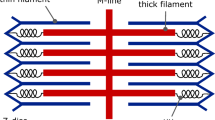Abstract
The study tests the hypothesis that the transition rate (G) of the cardiac cross-bridge (XB) from the strong force generating state to the weak state is a linear function of the sarcomere shortening velocity \(\left( {V_{{\text{SL}}} } \right)\). Force (F) was measured with a strain gauge in six trabeculae from the rat right ventricle in K-H solution \(\left[ {\left( {{\text{Ca}}} \right.} \right]_0 = 1.5\;{\text{mM,}}\;{\text{25}}{}^ \circ \left. {\text{C}} \right)\). Sarcomere length (SL) was measured with laser diffraction techniques. Twitch F at constant SL and the F response to shortening at constant \(V_{{\text{SL}}} \) \(\left( {0 - 8\mu {\text{m/s;}}\Delta {\text{SL}}\;{\text{50 - 100}}\;{\text{nm}}} \right)\) were measured at varied times during the twitch. The F response to shortening consisted of an initial fast exponential decline \(\left( {\tau {\text{ = 2}}\;{\text{ms}}} \right)\), followed by a slow decrease of F. The instantaneous difference (ΔF) between the isometric F(FM) and F during the slow phase depended on the duration of shortening (Δt), the instantaneous F M and V SL. \(\Delta F = G_1 \cdot F_{\text{M}} \cdot \Delta t \cdot V_{{\text{SL}}} \cdot (1 - V_{{\text{SL}}} /V_{{\text{MAX}}} )\) where V MAX is the unloaded V SL and G1 was \(\begin{gathered} 6.15 \pm 2.12\mu {\text{m}}^{ - {\text{1}}} \;\left( {{\text{mean}} \pm {\text{s}}{\text{.d}}{\text{.;}}n = 6} \right). \hfill \\ \Delta F/F_M \hfill \\ \end{gathered} \) was independent of the time onset of shortening. The linear interrelation between \(\Delta F\) and V SL is consistent with the suggested feedback, whereby XB kinetics depends on V SL. This feedback provides a more universal description of the interrelation between shortening and force, as well as the observed linear relation between energy consumption and the mechanical energy output. © 2000 Biomedical Engineering Society.PAC00: 8719Hh, 8719Ff, 8719Rr
Similar content being viewed by others
REFERENCES
Allen, D. G., and J. C. Kentish. The cellular basis of the length tension regulation in cardiac muscle. J.Mol Cell.Biol. 17:821–840, 1985.
Allen, D. G., and J. C. Kentish. Calcium concentration in the myoplasm of skinned ferret ventricle, following changes in muscle length. J.Physiol.(London) 407:489–503, 1988.
Brenner, B. Rapid dissociation and reassociation of actomyo-sin cross bridge during force generation: A newly observed facet of cross bridge action in muscle. Proc.Natl.Acad.Sci. U.S.A. 88:10490–10494, 1991.
Brenner, B., and E. Eisenberg. Rate of force generation in muscle: correlation with actomyosin ATPace activity in solution. Proc.Natl.Acad.Sci.U.S.A. 83:3542–3546, 1986.
Chalovich, J. M., and E. Eisenberg. The effect of troponin– tropomyosin on the binding of heavy meromyosin to actin in the presence of ATP. J.Biol.Chem. 261:5088–5093, 1986.
Daniels, N., M. I. Noble, H. E. D. J. ter Keurs, and B. Vohlfart. Velocity of sarcomere shortening in rat cardiac muscle: Relationship to force, sarcomere length, calcium, and time. J.Physiol.(London) 355:367–381, 1984.
de Tombe, P. P., and H. E. D. J. ter Keurs. An internal viscous element limits unloaded velocity of sarcomere shortening in rat myocardium. J.Physiol.(London) 454:619–642, 1992.
Eisenberg, E., and T. L. Hill. Muscle contraction and free energy transduction in biological system. Science 227:999–1006, 1985.
Fenn, W. O. A quantitative comparison between the energy liberation and work performed by the isolated sartorious muscle of the frog. J.Physiol.(London) 58:175–203, 1923.
Greene, L. E., D. L. Williams, and E. Eisenberg. Regulation of actomyosin ATPase by troponin–tropomyosin: Effect of the binding of the myosin subfragment-1 ATP complex. Proc.Natl.Acad.Sci.U.S.A. 84:3102–3106, 1987.
Hill, A. V. The effect of load on the heat of shortening. Proc. R.Soc.London, Ser.B 159:297–318, 1964.
Hill, T. L. Two element models for the regulation of skeletal muscle contraction by calcium. Biophys.J. 44:383–396, 1983.
Hisano, G., and I. V. Cooper. Correlation of force-length area with oxygen consumption in ferret papillary muscle. Circ. Res. 61:318–328, 1987.
Huxley, A. F. Muscle structure and theories of contraction. Prog.Biophys.Chem. 7:255–318, 1957.
Huxley, A. F. Muscle contraction. J.Physiol.(London) 243:1–43, 1974.
Landesberg, A. End systolic pressure–volume relation based on the intracellular control of contraction. Am.J.Physiol. 270: H338–H349, 1996.
Landesberg, A., and S. Sideman. Coupling calcium binding to troponin-C and cross bridge cycling in skinned cardiac cells. Am.J.Physiol. 266: H1260–H1266, 1994.
Landesberg, A., and S. Sideman. Mechanical regulation in the cardiac muscle by coupling calcium binding to troponin 977 Analysis of Crossbridge Dynamics.with cross bridge cycling. A dynamic model. Am.J.Physiol. 267:H779–H795, 1994.
Landesberg, A., and S. Sideman. Regulation of energy consumption in the cardiac muscle; analysis of isometric contractions. Am.J.Physiol. 276:H998–H1011, 1999.
Landesberg, A., and S. Sideman. Force velocity relationship and biochemical to mechanical energy conversion by the sarcomere. Am.J.Physiol. 278:H1274–H1284, 2000.
Leach, J. K., A. J. Brady, B. J. Skipper, and D. L. Millar. Effect of active shortening on tension development of rabbit papillary muscle. Am.J.Physiol. 238:H8–H13, 1980.
Lehrer, S. S. The regulatory switch of the muscle thin filament: Calcium or myosin heads? J.Muscle Res.Cell Motil. 15:232–236, 1994.
Lombardi, V., G. Puazzesi, and M. Linari. Rapid regeneration of actin-myosin power stroke in contracting muscle. Nature (London) 355:638–641, 1992.
Mommaerts, M. F. H. M., I. Seraydarian, and G. Marechal. Work and mechanical change in isotonic muscular contrac-tions. Biochem.Biophys.Acta. 57:1–12, 1962.
Peterson, J. N., W. C. Hunter, and M. R. Berman. Estimated time course of calcium bound to troponin-c during relaxation in isolated cardiac muscle. Am.J.Physiol. 260:H1013–H1024, 1991.
Rall, J. A. Sense and nonsense about the Fenn Effect. Am.J. Physiol. 242:H1–H6, 1982.
Sagawa, K., L. Maughan, H. Suga, and K. Sanagawa. Cardiac Contraction and the Pressure–Volume Relationship. New York: Oxford University Press, 1988, p. 190.
Stein, L. A., P. B. Chock, and E. Eisenberg. The rate limiting step in the actomyosin adenosine triphosphatase cycle. Biochemistry 23:1555–1563, 1984.
Suga, H. Ventricular energetics. Physiol.Rev. 70:247–277, 1990.
Zahalak, G. I. A distribution-moment approximation for ki-netic theories of muscular contraction. Math.Biosci. 55:89–114, 1981.
Author information
Authors and Affiliations
Rights and permissions
About this article
Cite this article
Landesberg, A., Livshitz, L. & ter Keurs, H.E.D.J. The Effect of Sarcomere Shortening Velocity on Force Generation, Analysis, and Verification of Models for Crossbridge Dynamics. Annals of Biomedical Engineering 28, 968–978 (2000). https://doi.org/10.1114/1.1321013
Issue Date:
DOI: https://doi.org/10.1114/1.1321013




